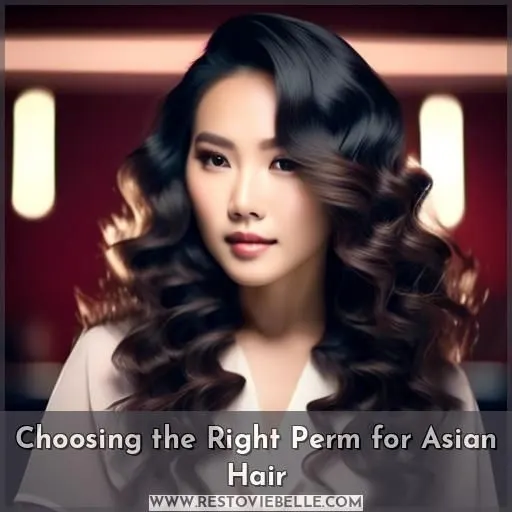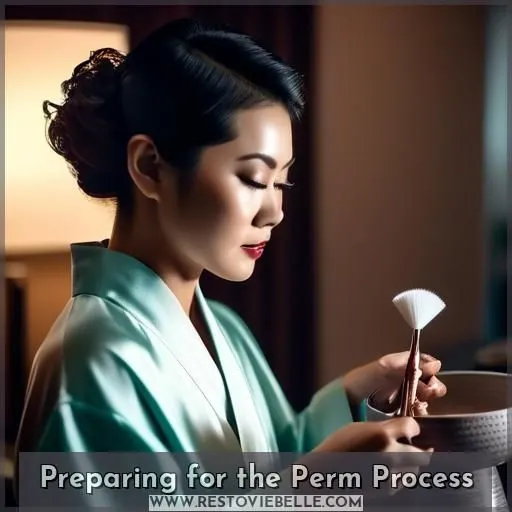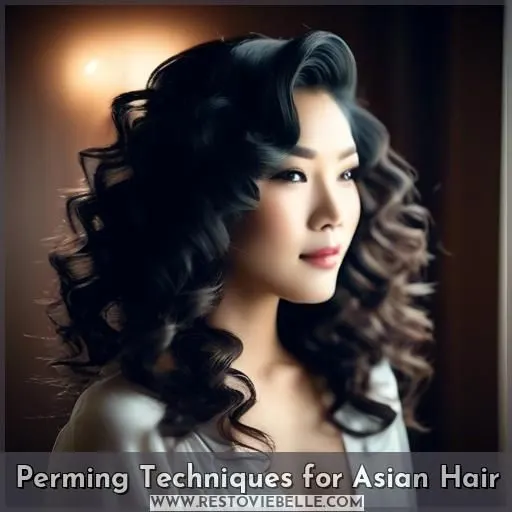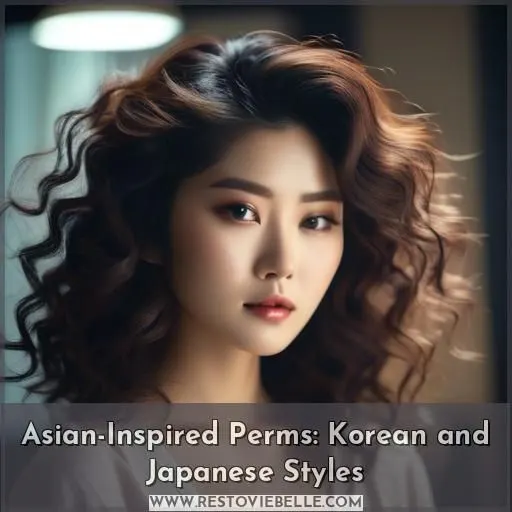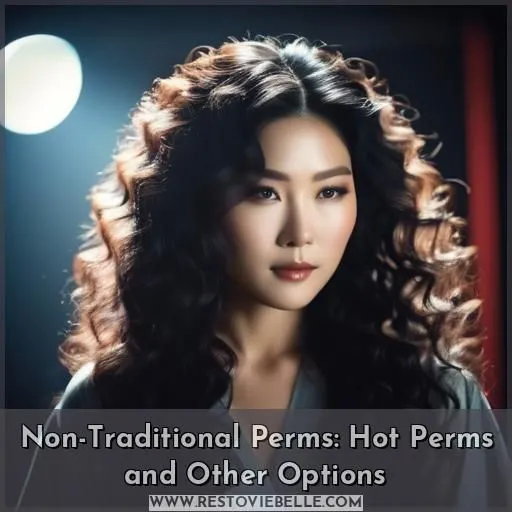This site is supported by our readers. We may earn a commission, at no cost to you, if you purchase through links.
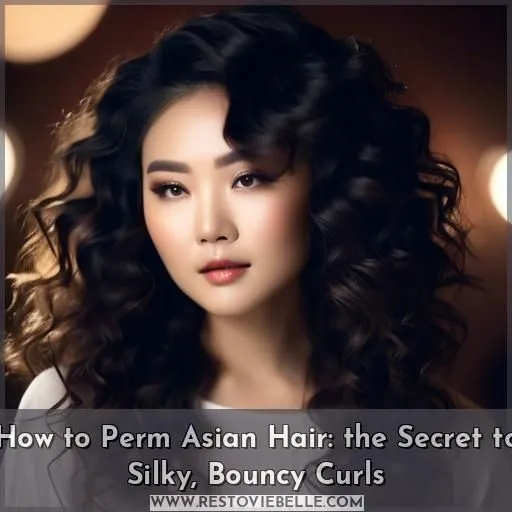
To attain lustrous, resilient curls on your Asian tresses, opt for a regular-potency perm solution designed specifically for thick, unyielding strands.
Select rods two sizes smaller than the desired curl pattern.
Cleanse hair thoroughly before wrapping sections with uniform tension.
Towel-dry hair before applying the waving lotion.
Allow the rods to oxidize naturally in the air for 30 minutes.
After-perm care is paramount.
Gently pat hair dry.
Apply a curl cream.
Refrain from brushing or heat-drying.
Utilize setting rollers or dry shampoo.
Minimize the use of heated rollers for the first month to preserve the integrity of your newly-transformed locks.
Eager to delve deeper into the intricate details?
Table Of Contents
- Key Takeaways
- How to Perm Asian Hair?
- Choosing the Right Perm for Asian Hair
- Preparing for the Perm Process
- Rod Selection and Placement
- Perming Techniques for Asian Hair
- Post-Perm Care and Maintenance
- Asian-Inspired Perms: Korean and Japanese Styles
- Non-Traditional Perms: Hot Perms and Other Options
- Traditional Perms: Pros and Cons
- Frequently Asked Questions (FAQs)
- Conclusion
Key Takeaways
- Choose a regular-potency perm solution designed for thick, unyielding strands.
- Use rods two sizes smaller than the desired curl pattern.
- Apply a curl cream and avoid brushing or heat-drying after the perm process.
- Use setting rollers or dry shampoo for post-perm care, and minimize the use of heated rollers for the first month.
How to Perm Asian Hair?
To perm Asian hair and achieve silky, bouncy curls, it’s imperative to locate a salon with proficiency in Korean wave perms and employ products specifically formulated for damaged hair post-perm. Routine trims and refraining from harsh treatments aid in preserving the perm’s efficacy.
Choosing the Right Perm for Asian Hair
Are you an Asian with straight, fine hair? Choosing the appropriate perm solution and post-perm maintenance regimen is essential for obtaining elegant, resilient curls that endure. From selecting the suitable perm solution to preserving your fresh perm, we’ve you taken care of.
Asian Hair Characteristics
Asian hair, with its rich perm history, is the canvas for transformation. In East Asian countries, the art of perming has evolved, blending tradition with innovation. From the Japanese invention of hot perms to the enduring use of alkaline chemicals like ammonium thioglycolate, the quest for silky, bouncy curls reflects a journey of mastery and liberation.
Perm Solution Selection
To choose the right perm for your Asian hair, consider the following factors:
- Hair Type: Asian hair tends to be thick and straight, so a perm solution with a normal strength is ideal. Avoid acid-based formulas or using perm solutions on over-lightened hair.
- Lotion Strength: Opt for an alkaline-based lotion with a normal strength, as it’s best suited for Asian hair.
- Rod Size: Use rods two sizes smaller than desired curl to achieve the desired curl pattern. Perms relax by two rod sizes over time.
- Perm Process: Clarify hair before perming, wind sections with even tension, blot hair before rinsing waving lotion, and rinse thoroughly for several minutes. Air oxidize rods for 30 minutes before neutralizing.
- Post-Perm Care: Blot hair dry and apply curl balm, avoid brushing or blow-drying, use setting rollers and dry shampoo, and avoid straightening irons for a month. Use heated rollers sparingly.
Post-Perm Care
After the perm process, it’s essential to follow post-perm care instructions for long-lasting results. This includes:
- Patting hair dry
- Applying curl cream
- Avoiding combing or blow-drying
Use:
- Curling rollers
- Dry shampoo
Refrain from using straightening irons for a month.
For product recommendations, consider:
- British Organics Annatto Hair Oil
- Meg Steam Hair Mask
Regular care is vital for extending the lifespan of a perm.
Preparing for the Perm Process
- Clarify Hair Before Perm: Use a clarifying shampoo to remove any buildup that could interfere with the perm solution.
- Sectioning Techniques: Wind sections with even tension, ensuring that each section is wrapped around the rod consistently.
- Tension Control and Blot Drying: Apply curl definition lotion, then blot the hair before rinsing the waving lotion. This helps to control the tension and define the curls.
Rod Selection and Placement
When perming Asian hair, you’ll want to select rod sizes two sizes smaller than your desired curl pattern.
The curl will relax and open up by approximately two rod sizes over time.
Before winding the hair onto the rods, it’s essential to clarify the hair thoroughly.
This is to remove any product buildup or residue that could interfere with the perm processing.
Rod Selection and Placement
After clarifying your hair, it’s time to choose your rod size wisely. Think Linda Cardellini’s enviable waves or Emma Stone’s playful curls. Aim for even tension as you wrap, ensuring each strand’s snug as a bug. Before rinsing, blot like you’re dabbing away life’s little mistakes. Remember, air oxidation pre-neutralizing is your secret weapon.
Clarify Hair Before Perm
Before you venture into the realm of perms, it’s essential to determine your objectives, expectations, hair texture, and scalp health.
This step lays the groundwork for a successful perm procedure.
Prepare your hair by washing it with a mild shampoo to eliminate any buildup or impurities.
This will facilitate the penetration of the perm solution, resulting in a more uniform curl pattern.
Furthermore, clarifying your scalp can mitigate irritation or discomfort during the perm process.
Post-Perm Care
Post-perm care is essential for preserving your new curls.
Deep condition your hair routinely to maintain its health and hydration.
Employ styling techniques such as setting rollers and utilizing dry shampoo to enhance your curls.
Refrain from using heat styling tools such as straightening irons for a month. Sparingly employ heated rollers.
Product recommendations encompass curl balms and hair masks to nourish your curls.
Bear in mind, maintenance is paramount to extending the lifespan of a perm.
Perming Techniques for Asian Hair
Regarding Asian hair perming, certain considerations are imperative for successful outcomes. Firstly, selecting the appropriate perm solution and lotion is paramount, taking into account your hair’s texture. Alkaline-based lotions of moderate strength are advisable, whereas acid-based formulations should be avoided for overly lightened hair. Moreover, utilizing rods two sizes smaller than your desired curl and applying even tension during the perming process is essential.
The perm procedure encompasses clarifying your hair pre-treatment, winding sections with consistent tension, and gently patting dry before rinsing the waving lotion. Post-perm, it’s vital to allow the rods to air oxidize for 30 minutes prior to neutralizing the perm solution. Post-perm care entails gently blotting dry, applying a curl balm, refraining from brushing or blow-drying, using setting rollers and dry shampoo, and minimizing the use of heated rollers.
Asian perms have gained widespread popularity in Asia over the years, known for their subtle, natural-looking effects. They’re more affordable in Asia compared to the United States and are commonly used to create wash-and-wear beachy waves. Alternative perms, such as hot perms, are also available and can produce a more natural wave while enhancing hair’s softness and shine. However, traditional perms, which involve immersing hair in alkaline chemicals, can result in tighter, bouncier curls but may require additional styling products and generally appear less natural.
Ultimately, the choice of perm technique should align with your desired appearance and hair type. Consulting with a professional stylist is highly recommended to determine the most suitable perm for your hair and to adhere to their guidance for achieving optimal results.
Post-Perm Care and Maintenance
After getting a Korean perm, it’s essential to take appropriate care of your hair to preserve the curls and keep them looking their best. Here are some tips on post-perm care and maintenance:
- Wait before washing: Avoid washing your hair for at least 48 hours after the perm to allow the hair to set and the curls to settle.
- Use curl-enhancing products: Apply curl balm or other curl-enhancing products to keep your curls in place and looking bouncy.
- Avoid heat-styling tools: Refrain from using curling irons, straighteners, or blow dryers to prevent damage to your perm.
- Use setting rollers: Instead of heat-styling tools, use setting rollers to set your curls overnight.
- Dry shampoo: Use dry shampoo on your roots if your hair gets dirty in between washes to absorb oil and dirt.
- Monthly straightening: Limit the use of heated rollers or other styling tools to once a month to prevent damage to your perm.
- Regular trims: Get regular trims every 6-8 weeks to keep split ends at bay and maintain the health of your perm.
Asian-Inspired Perms: Korean and Japanese Styles
In the world of Asian hair, Korean and Japanese perms are unparalleled, offering a path to effortless elegance.
These styles are a testament to natural beauty, with beachy waves that evoke coastal adventures.
Choose a Korean perm and you’ll find yourself adorned with a look that’s as carefree as it’s stylish—expect minimal morning fuss and maximum allure.
The Japanese perm promises similar freedom, bestowing upon you a natural perm that’s both subtle and sophisticated.
Embrace these styles and conquer your hair with flair.
Non-Traditional Perms: Hot Perms and Other Options
Non-traditional perms, like hot perms, offer a distinctive take on the classic perm.
These perms are activated by heat, resulting in a more natural wave that leaves hair softer and shinier.
However, they come with a higher cost than traditional perms.
It’s essential to bear in mind your hair texture and the possibility of chemical damage when selecting a perm.
Home perms aren’t advisable due to the risk of damage and inconsistent results.
Always seek advice from a professional to identify the most suitable perm option for your Asian hair care requirements.
Traditional Perms: Pros and Cons
Traditional perms, also known as cold perms, involve soaking hair in alkaline chemicals to create tighter, bouncier curls. They require more styling products and generally look less natural compared to non-traditional perms. However, they’ve some advantages and disadvantages to mull over before deciding to get one.
On the positive side, traditional perms can last for around a year, making them a long-lasting option for those who want to maintain curls for an extended period. They’re suitable for all hair types, including Asian hair, and can create a wide range of curl patterns. Additionally, traditional perms are often less expensive than non-traditional perms, such as hot perms.
However, traditional perms can be damaging to the hair, as they involve the use of strong chemicals that can weaken the hair and cause breakage. Overuse of perm solutions can lead to hair loss and breakage. It’s imperative to follow proper aftercare instructions, such as using sulfate-free shampoos and moisturizing conditioners, to minimize damage.
Another drawback of traditional perms is that they require more styling products to maintain the curls, which can be time-consuming and costly in the long run. They also may not be suitable for everyone, as people with colored or bleached hair, thin, fine hair, or damaged hair should avoid getting a perm.
Frequently Asked Questions (FAQs)
How often should I get a perm touch-up?
You’ll want a perm touch-up every 3-4 months to maintain those luscious, beachy waves. The chemicals gradually lose their oomph, so regular top-ups guarantee your mane stays fabulous and full of life. Don’t let those curls go flat – own that radiant, confident look!
Can I perm my hair if it is colored or bleached?
Riding the color wave’s a hair-raising risk – the bleach and dye could leave your locks too parched for perming’s harsh embrace. Better wave goodbye to that vibrant shade before snuggling up with those curly rods, babe.
Is it safe to perm my hair if I have fine or thin hair?
No, you shouldn’t perm fine or thin hair. The harsh chemicals will likely cause excessive damage, leading to dry, brittle strands that break easily. Embrace your natural texture instead – your locks will thank you!
Can I perm my hair at home?
You’re craving that beachy wave, aren’t you? Hold up – perming at home is a hair-raising idea. Those chemicals require professional finesse to avoid a frizzled disaster. Trust the experts to tame your tresses safely.
How long does a perm last?
A well-done perm can last up to a year, but typically starts loosening after 6 months. The tighter the curl pattern, the longer it’ll hold—those beachy waves may only stick around 3-4 months. Proper aftercare is key to making those luscious locks last!
Conclusion
Unlocking your hair’s true potential demands patience and commitment when perming Asian strands. By choosing the suitable solution, carefully wrapping each strand, and caring for your freshly-transformed locks, you’ll reveal silky, bouncy curls that radiate confidence. Master the art of how to perm Asian hair, and let your gorgeous mane capture attention wherever you go.
